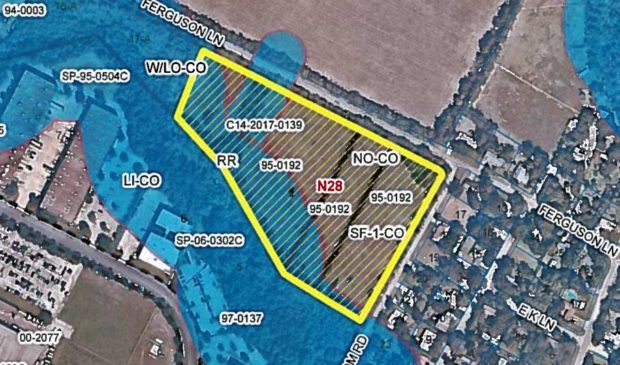Commission votes to allow residential buffer between neighborhood and small business development
Friday, April 20, 2018 by
Sommer Brugal At its April 17 meeting, the Zoning and Platting Commission approved a rezoning on Ferguson Lane and Sansom Road, despite strong urges to reject the proposal from the residents of Walnut Place Neighborhood Association. The agreed-upon motion includes a residential barrier along the east side of the lot.
Originally, developers had requested the site at 3207 Ferguson Lane be rezoned from a mix of commercial and residential uses – Warehouse/Limited Office (W/LO), Rural Residential (RR), Neighborhood Office (NO) and Single Family Residence-Large Lot (SF-1) – to W/LO in its entirety. But that proposal received strong pushback from WPNA residents. The latest proposal, according to Colin Armstrong, one of the project’s developers, takes into account the neighborhood’s suggestions and requests that had been voiced since talk between both parties began in early 2017.
“We’ve created a residential buffer to reduce both the visual and the noise impacts (of the development), as well as, we hope, enhance the landscaping and compatibility between all parties,” stated Armstrong.
Though the residential strip was added to adhere to the wishes of WPNA residents, it remained one of the more contested aspects of the plan. According to Commissioner Betsy Greenberg, the debate was partially due to the lack of awareness around the addition. She cited that the zoning request presented at the meeting had not been amended.
“I understand the objection, even if there is a residential buffer,” stated Greenberg. “The concern is, for me, whether residential buildings would actually ever get built there.” She voiced empathy for the residents and stated she herself would not like to live next to the development.
Just as people don’t want to live across the street from the development, she said, most people wouldn’t want to live in front of it. Commissioner Sunil Lavani, however, said that decision wasn’t for the commission to make.
“In terms of potential buyers, I think there’s definitely a demand, whether single family or some form of residential (units),” said Lavani. Given the project’s intention to house both small businesses and residential homes, he argued that the proposed location was an appropriate one.
Commissioner David King disagreed and shifted the discussion to the business intention of the project. He said one of his main concerns related to the fundamental purpose of the W/LO zoning category. From what he could see, King says the site was not functioning in accordance to the fundamental basics of the category.
“I heard that these buildings were going to be for smaller warehouses, (but) I didn’t see any of that in the background,” stated King. He said he didn’t have enough information to know the true purpose of the development or how it would be used. “I’m not comfortable voting on this zoning decision without enough information.”
King also asked what kind of truck traffic would be allowed to travel within the neighborhood and how those rules would be enforced.
The association’s consultant Jim Wittliff, along with a number of Walnut Place residents, spoke against the rezoning request. They said the added noise, traffic and visual counts would negatively impact the neighborhood’s appeal, property value and overall quality of life.
When asked what terms would make the proposal more acceptable, though, Wittliff said building the residential strip first. If it wasn’t, he argued it wouldn’t get built at all. He requested certificates of occupancy for all residential units prior to the acquirement of certificates on the warehouse units.
The final proposal included the addition of a 125-foot residential buffer and Multi-Family Residence-Limited Density (MF-1) zoning on Sansom Road, with the remaining land being classified as W/LO. The motion passed 6-3, with commissioners Greenberg, King and Jolene Kiolbassa opposing.
The Austin Monitor’s work is made possible by donations from the community. Though our reporting covers donors from time to time, we are careful to keep business and editorial efforts separate while maintaining transparency. A complete list of donors is available here, and our code of ethics is explained here.
You're a community leader
And we’re honored you look to us for serious, in-depth news. You know a strong community needs local and dedicated watchdog reporting. We’re here for you and that won’t change. Now will you take the powerful next step and support our nonprofit news organization?








